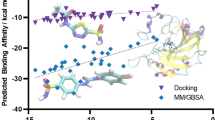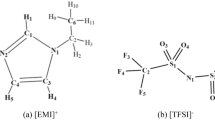Abstract
A molecular mechanics (MM) analysis is carried out on complexes of crown ethers CH2(OCH2CH2)nCH2O, 12-crown-4 (n=3), 15-crown-5 (n=4), 18-crown-6 (n=5), 24-crown-8 (n=7), and 30-crown-11 (n=9) to determine the nature of the selectivity shown by these ligands for metal ions on the basis of metal ion size. The MM program used is SYBYL, and M-O bonds are represented using a ‘covalent’ model, i.e. the M-O bonds are modelled with ideal M-O bond lengths and force constants. The previously used technique of calculating strain energy as a function of M-O bond length is used for all the complexes, and also the complexes of the non-macrocyclic polyethylene glycol analogues. It is concluded that the crown ethers fall into three groups with regard to selectivity for metal ions. Group one consists of the smaller macrocycles such as 12-crown-4 and 15-crown-5, where metal ions generally are too large to enter the cavity of the macrocycle, and the metal ion is coordinated lying outside the plane of the donor atoms of the ligand. Here factors that control selectivity are the same as in non-macrocyclic ligands, chiefly the size of the chelate ring. Group 2 contains only 18-crown-6 of the ligands studied here. 18-Crown-6 complexes have three important conformers, one of which, theD 3d , shows sharp size match selectivity, preferring metal ions with M-O bond lengths of about 2.9 Å. The other two conformers are adopted by metal ions too small for theD 3d conformer, and are more flexible, exerting little size-match selectivity. These other two conformers are of higher energy than theD 3d conformer for metal ions with M-O bond lengths greater than 2.55 Å. Thus, a genuine ‘size match selectivity’ is found for K+ with 18-crown-6. With an ideal M-O bond length of 2.88 Å, K+ fits the cavity of theD 3d conformer of 18-crown-6 very closely. The third group consists of very large macrocycles such as 24-crown-8 and 30-crown-10. These enfold the metal ion in extremely folded conformations, but may, as does 30-crown-10, exert considerable selectivity for metal ions on the basis of their size by virtue of the conformation resulting in a set of torsional angles in the ring atoms of the macrocycle which confer considerable rigidity on the ligand.
Similar content being viewed by others
References
C.J. Pedersen:J. Am. Chem. Soc. 89, 2459 (1967).
R.M. Izatt, K. Pawlak, J.S. Bradshaw, and R.L. Bruening:Chem. Rev. 91, 1721.
R.D. Hancock:J. Chem. Educ. 69, 615 (1992).
G.W. Gokel:Crown Ethers and Cryptands, The Royal Society of Chemistry, 1991.
V.J. Thom, C.C. Fox, J.C.A. Boeyens, and R.D. Hancock:J. Am. Chem. Soc. 106, 5947 (1984).
R.D. Hancock:Acc. Chem. Res. 23, 253 (1990).
R.D. Hancock:Progr. Chem. 37, 187 (1989).
R.D. Hancock: inPerspectives in Coordination Chemistry, A.F. Williams, C. Floriani, and A.E. Merbach, Eds., Verlag Helvetica Chimica Acta, Basel, 1992, pp. 129–151.
R.A. Bartsch, B.P. Csech, S.I. Kang, L.E. Stewart, W. Wolkowitz, W.A. Charewicz, G.S. Heo, and B. Son:J. Am. Chem. Soc. 104, 3249 (1982).
G. Wipff, P. Weiner, and P.A. Kollman:J. Am. Chem. Soc. 104, 3249 (1982).
P.D.J. Grootenhuis, and P.A. Kollman:J. Am. Chem. Soc. 111, 2152 (1989).
K.V. Damu, R.D. Hancock, P.W. Wade, J.C.A. Boeyens, D.G. Billing, and S.M. Dobson:J. Chem. Soc., Dalton Trans. 293 (1991).
SYBYL program, available from TRIPOS associates, 1699 South Hanley Road, St Louis, MO 63144, U.S.A.
M. Clark, R.D. Cramer, and N. van Opdenbosch:J. Comput. Chem. 10, 982 (1989).
P.V. Bernhardt and P. Comba:Helv. Chim. Acta 74, 1834 (1991).
A.M. Bond, T.W. Hambley, and M.R. Snow:Inorg. Chem. 24, 1920 (1985).
M. Dobler and R.P. Phizackerley:Acta Crystallogr., Sect B B30, 2746 (1974).
M. Dobler and R.P. Phizackerley:Acta Crystallogr., Sect B B30, 2748 (1974).
R.D. Shannon:Acta Crystallogr., Sect A A32, 751 (1976).
R.D. Rogers, A.H. Bond, and S. Aguinaga:J. Am. Chem. Soc. 114, 2960 (1992).
M.A. Bush and M.R. Truter:J. Chem. Soc., Perkin Trans. 2, 341 (1972).
P. Seiler, M. Dobler, and J.D. Dunitz:Acta Crystallogr., Sect B B30, 2744 (1974).
M. Dobler and J.D. Dunitz, and P. Seiler:Acta Crystallogr., Sect B B30, 2741 (1974).
N.W. Alcock, M. Ravindran, and G.R. Willey:J. Chem. Soc., Chem. Commun. 1063 (1989).
D.L. Hughes and J.N. Wingfield:J. Chem. Soc., Chem. Commun. 804 (1977).
D.L. Hughes, C.L. Mortimer, and M.R. Truter:Acta Crystallogr., Sect B B34, 800 (1978).
M.A. Bush and M.R. Truter:J. Chem. Soc., Perkin Trans. 2, 345 (1972).
R.D. Gandour, F.R. Fronczek, V.J. Gatto, C. Minganti, R.A. Schultz, B.D. White, K.A. Arnold, A.D. Mazzochi, S.R. Miller, and G.W. Gokel:J. Am. Chem. Soc. 108, 4078 (1986).
R.D. Rogers and K.L. Kurihara:Inorg. Chem. 26, 1498 (1987).
M.S.B. Munson:J. Am. Chem. Soc. 87, 2332 (1965).
R.W. Taft, J.F. Wolf, J.L. Beauchamp, G. Scorrano, and E.M. Arnett:J. Am. Chem. Soc. 100, 1240 (1978).
J.S. Uppal, and R.H. Staley:J. Am. Chem. Soc. 104, 125 (1982).
M.M. Kappes, and R.H. Staley:J. Am. Chem. Soc. 104, 1813 (1982).
R.M. Izatt, R.E. Terry, B.L. Haymore, L.D. Hansen, N.K. Dalley, A.G. Avondet, and J.J. Christensen:J. Am. Chem. Soc. 98, 7620 (1976).
B. Douglas, D.H. McDaniel, and J.J. Alexander:Concepts and Models of Inorganic Chemistry, 2nd Edition, Wiley, New York, 1983, p. 74.
Author information
Authors and Affiliations
Rights and permissions
About this article
Cite this article
Hancock, R.D. A molecular mechanics study of the selectivity of crown ethers for metal ions on the basis of their size. J Incl Phenom Macrocycl Chem 17, 63–80 (1994). https://doi.org/10.1007/BF00708001
Received:
Accepted:
Issue Date:
DOI: https://doi.org/10.1007/BF00708001




